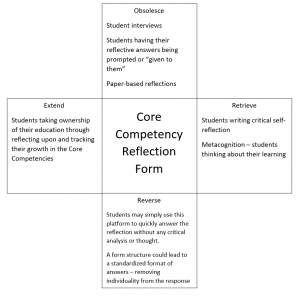A useful piece of feedback we received on our final project was having it pointed out that our tool is primarily targeting English speakers/writers without taking into consideration ways that ELL students could utilize this tool. This makes me recall Lum’s definition of media ecology where “the study of how change in the dominant form of communication media in society may facilitate large-scale cultural changes.” (2000, p. 3) I didn’t quite expect to have our project become an apt demonstration of how the dominant culture in my teaching environment permeated the tool Kalen and I developed for ALL of our students. It has been interesting to examine this project with the ontology of new materialism which, as a media theory, “can be seen as the intensive excavation of where (and when) actually is the materiality of media” (Parikka, 2012 , p. 98). When I examine the tool we’ve created with a new materialism lens, I become curious about the possible effect that a digital platform or “material” may have on my students. As digital tools, platforms, and interactions reinforce a pattern of instant gratification, will this tool’s material have a similar impact on my students where they rush through reflection; seeking the instant gratification of completing the task for completion’s sake? A paper-based reflection, although daunting to students with difficulties in written output, is entangled with a specific process and the understanding that a handwritten task will intrinsically take time to complete.
One additional concern about the tool came out during our testing as several students simply viewed the reflection as merely one more online assignment; one even less welcome perhaps as it invaded into their physical in-class time. A consideration for the future use of this tool will be to makes changes in the material or medium to maximize student engagement and participation in the reflection.
References
Casey Man Kong Lum (2000) Introduction: The intellectual roots of media ecology, New Jersey Journal of Communication, 8:1, 1-7, DOI: 1080/15456870009367375
Parikka, J. (2012). New materialism as media theory: Medianatures and dirty matter. Communication and Critical/Cultural Studies, 9(1), 95-100.
